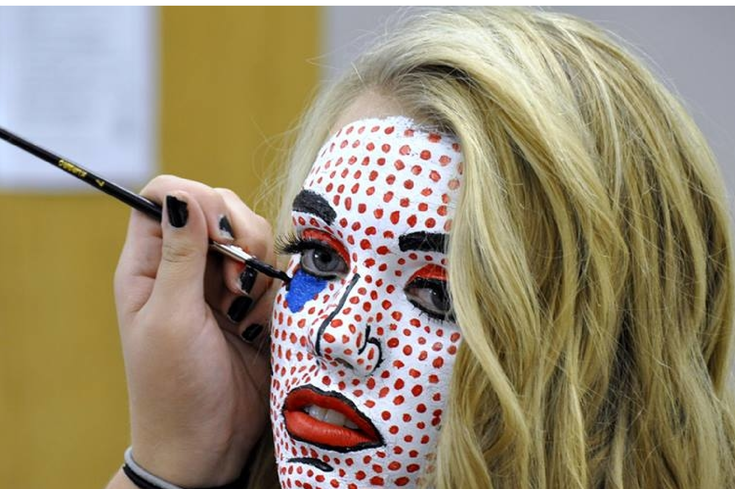What one skill you need to succeed Today
”Creative work is not a selfish act or a bid for attention on the part of the actor. It’s a gift to the world and every being in it. Don’t cheat us of your contribution. Give us what you’ve got.” ~Steven Pressfield
When I was a kid my two favorite things to make where, drawings of the Rice Krispie characters and to create paper balls. When I say paper balls, I don’t mean that I just crumbled a piece of paper into a ball, that would be kind of lame, and not worth writing about. I mean that I soaked strips of paper in water, and carefully laid each piece over the last, forming a 3D paper ball.
While I continued to enjoy art and creating, my confidence in my ability waned, as it does for most students starting at around 3rd grade. I began to believe that I couldn’t draw, and thus, I couldn’t draw. It’s funny how when we tell ourselves enough times that we can’t do something, eventually it becomes true.
While in college, during my sophomore review, the nerve wracking time when you stand in front of a group of professors with your artwork, and they tell you if you’re good enough to continue with your major. One of the professors commented that my drawings were a bit “grungy and messy.” But she didn’t stop there, she continued, why don’t you pay attention to your style, and your voice as an artist, work to bring more of that into your work. That advice always stayed with me. Because in that moment I knew two things, one, I’d passed and didn’t have to change my major, and two I realized that I could have a voice as an artist, and I remembered that young girl that “invented” paper balls, and I went in search for her.
It was a gradual discovery, but I found my voice as an artist, and more importantly as a creative thinker. Again, I believed that I could solve problems, that I had something interesting to bring into the world. While I still work as an artist, my creativity serving me well in that realm, I also work as a teacher and a business owner, where I’ve found my ability to think creatively essential.
Often the terms art and creativity become entangled to mean one and the same, but they aren’t. While you must be creative to be an artist, you do not have to be an artist to be creative.
“When I say artist I mean the one who is building things … some with a brush – some with a shovel – some choose a pen.” ~Jackson Pollock
We live in a culture that both loves and is terrified of art and creativity. When people ask what I do, and I respond, “ I’m a textile designer, and creativity educator. “ I might as well tell them that I”m a drug dealer.
They start to break into a cold sweat, and and quickly tell me that they can’t draw and they aren’t creative, just in case I was thinking about asking them to whip out their drawing pad and pencil and show me their sketching skills.
Now I could insert a lovely definition of creativity here, but instead I’m going to share some wisdom from the brilliant Mihaly Csikszentmihalyi, author of Flow and the Psychology of Discovery and Invention.
“ Creativity is a central source of meaning in our lives for several reasons. Here I want to mention only the two main ones. First, most of the things that are interesting, important, and human are the results of creativity. We share 98 percent of our genetic makeup with chimpanzees. What makes us different-our language, values, artistic expression, scientific understanding, and technology- is the result of individual ingenuity that was recognized, rewarded, and transmitted through learning. Without creativity, it would be difficult indeed to distinguish humans from apes.
The second reason creativity is so fascinating is that when we are involved in it, we feel that we are living more fully than during the rest of life. The excitement of the artist at the easel or the scientist in the lab comes close to the ideal fulfillment we all hope to get from life, and so rarely do. But creativity also leaves an outcome that adds to the richness and complexity of the future. “
We’re born with the ability to be creative thinkers, it’s our job to make the choice to nurture and challenge our creative minds. Your future depends on it.
Creative thinkers learn to :
1. Work as a team
2. They are able to make decisions and solve problems
3. They are able to plan, organize and prioritize work ( this is usually something that they need to practice, but can do well, as they are big picture thinkers)
4. They have a strong ability to communicate.
5. Creative thinkers are good at obtaining and processing information.
According to Forbes, the list above are 5 of the top things that employers are looking for in new hires. It’s time to say goodbye to the starving artist and hello to a creative revolution.
Registration for AP Art and AP Art History courses is now open. AP art courses are the perfect way to challenge and grow your creative mind. They’re about much more than making art. They’re about finding your voice, and understanding your vision. Through both creating art, and studying the history of art, students strengthen their creative thinking skills, and position themselves to make a great impact on the world around them.
